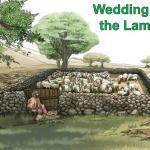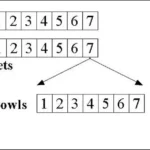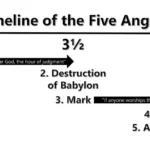What is syncretism?
Syncretism poses one of the greatest dangers of the end times especially at Easter which is particularly concerning for Christianity. Easter in its original form is purely and utterly syncretism–the mixing and blending of religious beliefs to form a new belief or religion. An abomination is something which is detestable or disgusting usually in the Biblical context relating to idolatry. But when examining occurrences in the Bible, abomination seems to relate the idea of the mixing of opposites, the mixing of good and evil or the mixing of things which shouldn’t be together such as in the case of homosexuality. And really syncretism is the mixing of beliefs or ideas that shouldn’t be together. Easter in its original context is syncretism or an abomination because it combines ancient beliefs with the death, burial and resurrection of Christ.
Syncretism is a big deal in missionary work. As many of you are aware I was a cross-cultural missionary for many years working with the Asengseng tribe in PNG. Syncretism raises its ugly head in many situations and has done so in Christian outreach for millennia.
Example in PNG
I remember when I was working in PNG hearing about how in a neighbouring language group, a Wycliffe Bible translator made some Biblical teaching audio tapes with the result being that a ‘cult’ or teaching group called the “kotngins” began. The Bible translator knew that teaching was needed but the error he made was that there was no follow up or corrective teaching being done so that the doctrine/teaching got misinterpreted, confused and twisted. He left the teaching to untrained and inexperienced tribal “believers” who may or may not have truly believed in Jesus in the first place. The result was syncretism! You can’t translate a New Testament and then do no teaching or even allow unsupervised teaching without proper training. Satan will do his best to twist it into a syncretised belief system. Reminds me of the savage wolves that came in after the Apostle Paul left.1 Satan is that savage wolf and he has his workers.
A missionary friend of mine who still works in the area said, “I heard another missionary say that it was like those teachers (kotngins) were going around inoculating people against the true gospel. I remember one thing that they were doing. When they came into a new village to teach they would hug the wives of the men there. If the husbands didn’t get upset, then they knew that they would be receptive to the gospel.”
It was like those teachers were going around inoculating people against the true gospel. When they ("kotngins"-false teachers) came into a new village to teach they would hug the wives of the men there. If the husbands didn't get upset, then they knew that they would be receptive to the gospel.
The syncretised religion of Easter (Ishtar)
The following historical information was taken from a sermon by Tim Warner.2 Let me first say that it is not my intent to disrespect people who celebrate the death, burial and resurrection of Christ at Easter. Everyone has to do what they think is right but I say this in being responsible as a teacher of the Word so that we are not misinformed. We all must make informed decisions on what we find out and what we hear. I’m not apologising for what I teach but I’m telling you what I have learnt about syncretism over the years from God’s Word.
Easter is in spring in the northern hemisphere and in the spring all things become new. In the ancient times, calendars were developed according to seasons including the Babylonians, the Persians and other empires. Their calendars almost always began in the spring often on what we call the spring or vernal equinox. The spring equinox was when the length of the night was equal to the length of the daytime. The opposites are the winter and summer solstices. The spring equinox on our Gregorian calendar is on the 21st March but the ancients began their new years in March. Originally the Roman calendar began in March. You might notice that the month of September means “seven”, October means “eight”, November means “nine” and the month of December means “ten”. The reason is that the calendar started in spring in March but somewhere along the way the calendar got changed.
Each of these cultures, because they didn’t know the true God, had pagan idols and mythological gods and goddesses that they worshipped. Accordingly some of these different gods represented the seasons.
There was the goddess of the spring, the goddess of sex and fertility. The Babylonians called her Ishtar. The Egyptians called her Isis, the Sumerians Inanna, the Sidonians Ashtoreth, the Greeks Astarte or Aphrodite, the Romans Venus, the Germans Eostre (Ostara), and the Anglo-Saxons called her Easter. Essentially these are all the same thing—the goddess of fertility—spring! They all had myths concerning these gods/goddesses.
The Babylonian myth concerning Ishtar
Ishtar had a sister of the underworld (hell) and Ishtar set out for the underworld to claim it for her own and on the way she passed through seven gates. At each gate she was required to leave a garment or an ornament so that at the seventh gate she was entirely naked. Despite the warning to not proceed in the netherworld she did not turn back but dared to sit on her sister Erishkigal’s throne. Immediately the Enuki judged her and gazed at her with eyes of death, she became a corpse and she was hung up on a nail. This parallels the fact that springtime eventuates into autumn where everything dies. The mythology revolved around the death of Ishtar. Ishtar had a son by the name of Tammuz but he was also her lover. (Remember this is all mythology) Tammuz then had to descend into the netherworld to secure the release and resurrection of his mother/lover, Ishtar. Now the Babylonians had a festival for this called “the mourning or weeping for Tammuz”.3 The women would get together just before the Spring Equinox and the women would all pretend to be crying and weeping for Tammuz because Tammuz had gone down into the netherworld and they didn’t know what had become of him. They didn’t know whether he was able to rescue Ishtar or not, the goddess of fertility and bring her back to life. But the festival concluded with the rising of the sun at the spring equinox.
Believe it or not this is the story of Easter—the real meaning of Easter long before Christ was born in 3 BC. It was celebrated by many different cultures with a similar theme but with variations.
Pope Gregory the Great
Pope Gregory the Great was the pope from AD 590-604. He decided to send out Catholic missionaries out to evangelise the Anglo-Saxon people. He ordered his missionaries to use all religious rites and festivals and to absorb them into Christian rituals where possible. The Christian celebration of the death and resurrection of Christ was ideally suited to be merged or syncretised with the pagan festival of Easter and many of the traditions of the pagan festivals were adopted into the Christian festivities.
So the Roman Catholics decided that the best way to evangelise was not to tell them to forsake their false idolatry and what they believed but to simply put Christian names on it. The name was Christ but they were really celebrating Ishtar/Easter.
The bunny rabbit was the symbol of the Anglo-Saxon version of Easter. A good symbol of fertility and spring. The ancient Babylonians and Persians coloured eggs and gave them as gifts to their goddess.
Conclusion
These are historical facts and there is no question that Easter has a pagan origin and it has been mixed up with Christianity over the years. The result is what we now call the syncretised Easter.
A lot of Christians think that it is perfectly harmless and that is your prerogative. It’s not up to me to judge—I’m merely bringing you information. I don’t think less of anyone who celebrates at this time although I do think it would be better to celebrate at the Passover time with a Christian perspective.4 It’s between you and God. It’s certainly something to think about.
But as we enter into the last days before Christ returns, there are other syncretised religions coming including Chrislam and a one world religion. We will be all asked to compromise in the last seven years by taking the beast’s mark (unless we go to the secret protected place) but we must stick to what is pure and unadulterated Christianity and stick clear of the abominations that come our way. Let me know what you think.
- Acts 20:29 [↩]
- “The true meaning of Easter” [↩]
- Eze. 8:14 [↩]
- 1 Cor. 5:8 [↩]

















5 Responses
Steve, a well written article.
My only question is, “what month of the year would you prefer us to celebrate the death and resurrection of Jesus”?
Brian
Hi Brian,
Good to hear from you. As Paul said in 1 Cor. 5:8 he said that the Corinthians were to keep the Festival (the Passover) not Easter! But they were to do it not in the old Jewish way but in the knowledge that Christ has come. It was only because of jealousy and antisemitism that the Roman church instructed the church in the 5th century to separate and hold an Easter festival which is predicated on the equinox and sun. The Jewish Passover is preicated on the moon. So let us celebrate the death and resurrection of Christ but let us do it at the Passover.
Blessings
Steve
I totally agree, over 40 years ago a godly Pastor warned me of the dangers of “syncretism”. I’ve witnessed its dangers to the Body of Messiah.
Eostre: a pagan springtime goddess Eostre celebrated during the spring equinox. Easter is a mistranslation of “pascha” in the KJV of the Bible; from the Hebrew “pesach”from a Latin word.
It was the Passover . According to John 19:31, “that Sabbath was a high day”.
I don’t have time to go into that..
The Apostle Paul states this in 1st Corinthians 5:7, “Messiah (Christ) our Passover has been sacrificed “.
Furthermore, in Exodus 20, “SH’MOT” in Hebrew. Hashem (Gd) makes it very clear about idol worship, 20:1-5. Hashem spells out His credentials verse 1, I am ADONAI your Gd, who brought you out of the land of Egypt, out of the abode of slavery”.
One of the reformers, John Calvin said; “the human heart is a factory of idols”!!! I’ve preached these truths from many pulpits.
Further reading: F.F. BRUCE, The Acts of the Apostles, Greek text with introduction and Commentary, Acts 12:4. Jamieson, Fausset, Brown, commentary on the whole Bible, Acts 12:4.
No Santa Clause, No Easter Bunny, No chicken or eggs, No idolatry, that’s what I’ve written in my Bible in Exodus 20.
End note, on my Facebook page I wrote a piece about what this time of the year is really all about. Fact: Passover this year 2024, starts April 23-30th.
Well said Robert. Great quote by Calvin too.
AMEN to that Steve!!